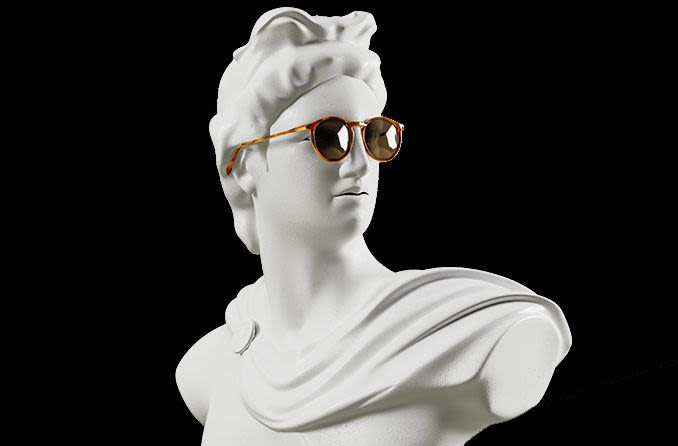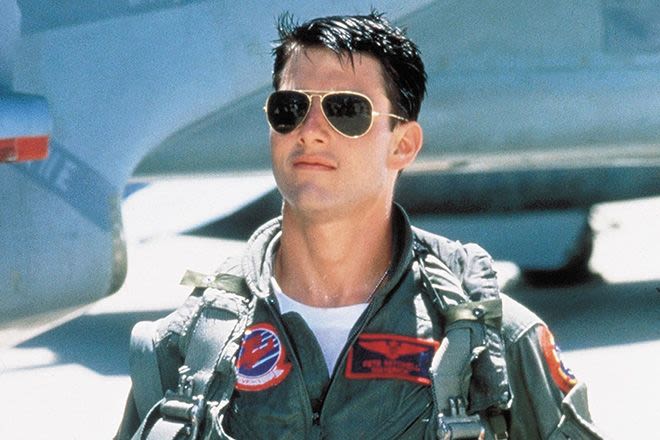The history of sunglasses: From Foster Grants to today

You should never leave home without your sunglasses – they protect your eyes and make you look cool. Yes, sunglasses are a huge part of our culture, but did you ever stop to think about how long they’ve been around and how they’ve evolved?
Believe it or not, the earliest sunglasses were actually worn in prehistoric times, and they’ve come a long, long way since. Read on to learn more about the history and evolution of sunglasses, our favorite fashionable and functional accessory.
Sunglasses: the early days
Based on artifacts that have been discovered, it appears that sunglasses date back to prehistoric Inuits who fashioned goggles that could protect them from the awful glare and pain of snow blindness.
These snow goggles shielded the eyes with only narrow slits in the front. Inuits also rubbed them with gunpowder or soot mixed with oil to further combat the sun glare off of the snow.
Although these weren’t “glasses” per se, the Inuits were onto an idea that wouldn’t be fully realized until centuries later.
The next major group to experiment with sunglasses were the ancient Chinese. However, they used them for a very different reason.
These “sunglasses” were used by judges who were supposed to remain stoic and impartial, and therefore wanted a way to hide their eyes and their emotions.
Sunglasses were seen again in the 1400s in Italy, where it’s said that the first pair of darkened glasses was first introduced, although there isn’t a lot of evidence to verify this.
A couple of centuries later, in the late 1700s, one of the biggest milestones in sunglasses history occurred. That’s when English optician James Ayscough made the recommendation to add tint to eyeglass lenses to treat vision problems.
From there, lenses that were tinted blue and green were developed.
Ayscough often is credited with being a major sunglasses pioneer.
The last major development that would ultimately influence future sunglasses came from Sir David Brewster (who also invented the kaleidoscope), during his studies on polarized light.
Brewster figured out the angle at which light on a reflective surface may be transmitted as plane-polarized. This came to be known as “Brewster’s Angle,” and without it, we wouldn’t have polarized sunglasses today.
Sunglasses go mainstream
Little by little, people began wearing tinted glasses to deal with eye issues including light sensitivity, which was a symptom of syphilis.
Sunglasses weren’t something that people with regular vision wore or wanted. In fact, people who wore them often stood out for having something wrong with their eyes.
All that changed in 1929, thanks to Sam Foster. Foster sold the first pair of sunglasses on the Atlantic City boardwalk intended for the mass market, and it was quite the hit among beachgoers.
The brand became known as Foster Grant, "The Original American Sunglass Brand," and today, they offer a full range of eyewear from sunglasses to Foster Grant reading glasses.
Meanwhile, in Hollywood, sunglasses were also starting to be associated with glamour and glitz. Back then, the strong lighting on movie sets and photographer flash bulbs were causing eye strain, so movie stars began wearing sunglasses in public to protect their eyes.
Then came 1936, when the American inventor Edwin H. Land (who also co-founded Polaroid) created a polarizing lightweight filter that could be produced inexpensively for use on sunglasses.
With that polarization technology in place, Bausch & Lomb developed Ray-Ban sunglasses, intended as anti-glare spectacles for pilots, and soon after, marketed them to outdoor enthusiasts.
While regular sunglasses cost a few cents, this style was considered a specialty item costing several dollars. The shape and tint of these sporting gear sunglasses ushered in the popular aviator sunglasses still popular today.
SEE RELATED: Foster Grant sunglasses

Tom Cruise in Top Gun (Image credit: Luxottica)
Sunglasses and pop culture
From the mid-20th century to the present, sunglasses have become a huge part of pop culture, with fashion icons, rock stars, actors and politicians sporting shades.
John Lennon, Bob Dylan, Audrey Hepburn and Bono are just a few celebrities who have their own signature sunglass style.
Other famous shades include Jackie O’s large, round sunglasses and the cat eye style worn by Marilyn Monroe that dominated the 1950s and 1960s.
The 1970s was all about oversized frames (think Lynda Carter in “Wonder Woman”), while the 1990s trend was smaller with colorful tints.
Tom Cruise’s “Risky Business” role made Wayfarers a popular look in the 1980s.
And perhaps no pop culture figure has done more to promote sunglasses than Elton John, who probably has one of the largest and most eclectic collections.
Songs that have been written about sunglasses or that mention sunglasses include ZZ Top’s “Cheap Sunglasses,” Corey Hart’s “Sunglasses at Night,” and The Eagle’s song “Boys of Summer,” which mentions Wayfarers.
And in film, sunglasses have had supporting roles in everything from “They Live” to “Men in Black,” not to mention giving so many characters memorable looks from “The Matrix” to “Scarface.”
Sunglasses today: So many options
With more awareness than ever before about the potential harm that can be done by the sun’s UV rays, sunglasses aren’t just a cool accessory, but a necessity – something the Inuit knew many centuries ago, even if they didn’t actually know about UV protection.
Today, though, from babies to seniors, you’ll see people wearing sunglasses year-round. We even have a National Sunglasses Day celebrated annually on June 27 to raise awareness about how wearing shades can protect your eyes.
Those who spend a significant amount of time outdoors or have a hard time with sun glare should invest in a good pair of sunglasses with polarized lenses that offer protection from both UVA and UVAB rays. (Bonus points if they also happen to look great!)
Today, you also can find sunglasses that fit over prescription glasses, flip up or clip onto regular frames, sports sunglasses and more. Photochromic lenses are another option as they automatically darken outdoors and lighten again indoors.
The good news is, with a range of retail options in store and online, you can find just about any style, shape, color and size sunglasses to fit your budget.
SEE RELATED: Different Types of Sunglasses: Styles, Shapes & Top Choices
Page published on Thursday, September 26, 2019






